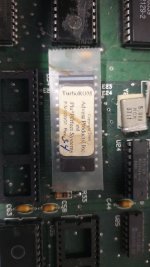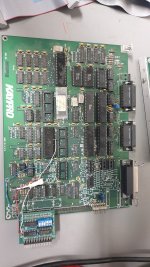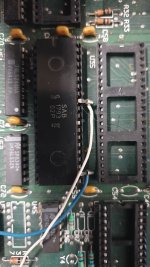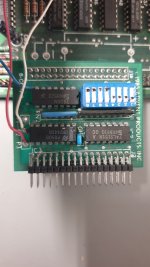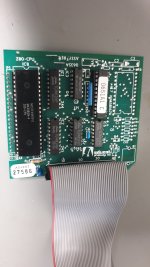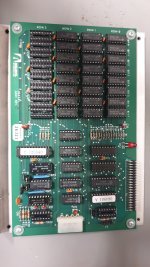bladamson
Veteran Member
Evenin' gentlemen.
In the same loot acquisition mission in which I obtained that ADM-3A+ and H-19, I also obtained this Kaypro 2-84 (and an Osborne 1, but I haven't cracked it open yet).
There were no screws in the case and some stuff was obviously damaged, so I figured I ought to tear it to pieces and figure out what I needed to have ordered while I finish the H-11.
It appears to have the Advent TurboROM installed, and was upgraded to double-sided drives.
It also appears to have a 1mb Advent RAM disk installed, with 768k populated.
I haven't dug around the web very hard for manuals yet, but apparently the TurboROM also adds support for 720k floppy drive and hard drives. I shall have to suss out what kind of hard drive interface is required for this, and if anyone cobbled together some kind of SD/flash/USB drive contraption for these things. Apparently the RAM drive interface is through a few IO ports rather than banking, so I don't think I can use it for a huge pile of banked RAM for Fuzix or something, unfortunately.
I tested the power supply and tested the video board enough to verify that I had high tension and a raster, but there are pins bent and broken on the Advent carrier that slots into the CPU socket so I haven't gone any farther than that. I'm not going to do anything else with it until I finish the H-11. I've gotta stop chasing so many shiny things at the same time and never finishing anything!
Anyway, I think it will be a neat machine. Some photos of the unusual stuff are attached, for those of you who are interested.
In the same loot acquisition mission in which I obtained that ADM-3A+ and H-19, I also obtained this Kaypro 2-84 (and an Osborne 1, but I haven't cracked it open yet).
There were no screws in the case and some stuff was obviously damaged, so I figured I ought to tear it to pieces and figure out what I needed to have ordered while I finish the H-11.
It appears to have the Advent TurboROM installed, and was upgraded to double-sided drives.
It also appears to have a 1mb Advent RAM disk installed, with 768k populated.
I haven't dug around the web very hard for manuals yet, but apparently the TurboROM also adds support for 720k floppy drive and hard drives. I shall have to suss out what kind of hard drive interface is required for this, and if anyone cobbled together some kind of SD/flash/USB drive contraption for these things. Apparently the RAM drive interface is through a few IO ports rather than banking, so I don't think I can use it for a huge pile of banked RAM for Fuzix or something, unfortunately.
I tested the power supply and tested the video board enough to verify that I had high tension and a raster, but there are pins bent and broken on the Advent carrier that slots into the CPU socket so I haven't gone any farther than that. I'm not going to do anything else with it until I finish the H-11. I've gotta stop chasing so many shiny things at the same time and never finishing anything!
Anyway, I think it will be a neat machine. Some photos of the unusual stuff are attached, for those of you who are interested.
Attachments
Last edited:

